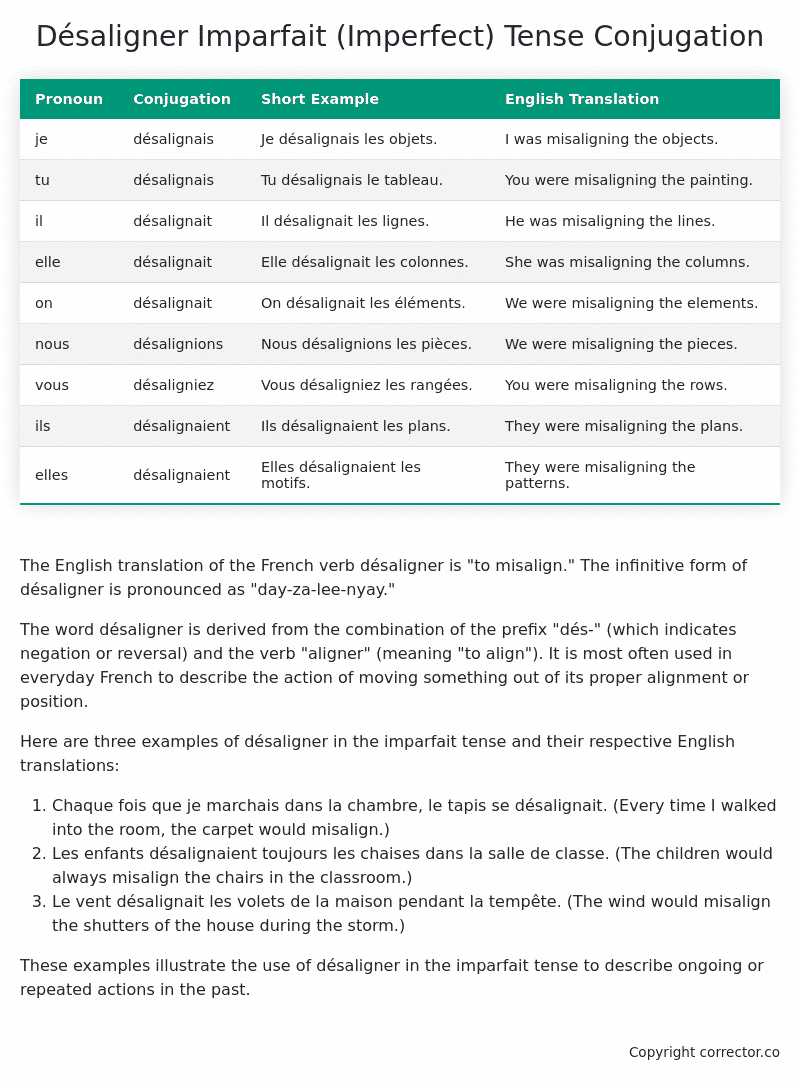Imparfait (Imperfect) Tense Conjugation of the French Verb désaligner
Introduction to the verb désaligner
The English translation of the French verb désaligner is “to misalign.” The infinitive form of désaligner is pronounced as “day-za-lee-nyay.”
The word désaligner is derived from the combination of the prefix “dés-” (which indicates negation or reversal) and the verb “aligner” (meaning “to align”). It is most often used in everyday French to describe the action of moving something out of its proper alignment or position.
Here are three examples of désaligner in the imparfait tense and their respective English translations:
- Chaque fois que je marchais dans la chambre, le tapis se désalignait. (Every time I walked into the room, the carpet would misalign.)
- Les enfants désalignaient toujours les chaises dans la salle de classe. (The children would always misalign the chairs in the classroom.)
- Le vent désalignait les volets de la maison pendant la tempête. (The wind would misalign the shutters of the house during the storm.)
These examples illustrate the use of désaligner in the imparfait tense to describe ongoing or repeated actions in the past.
Table of the Imparfait (Imperfect) Tense Conjugation of désaligner
| Pronoun | Conjugation | Short Example | English Translation |
|---|---|---|---|
| je | désalignais | Je désalignais les objets. | I was misaligning the objects. |
| tu | désalignais | Tu désalignais le tableau. | You were misaligning the painting. |
| il | désalignait | Il désalignait les lignes. | He was misaligning the lines. |
| elle | désalignait | Elle désalignait les colonnes. | She was misaligning the columns. |
| on | désalignait | On désalignait les éléments. | We were misaligning the elements. |
| nous | désalignions | Nous désalignions les pièces. | We were misaligning the pieces. |
| vous | désaligniez | Vous désaligniez les rangées. | You were misaligning the rows. |
| ils | désalignaient | Ils désalignaient les plans. | They were misaligning the plans. |
| elles | désalignaient | Elles désalignaient les motifs. | They were misaligning the patterns. |
Other Conjugations for Désaligner.
Le Present (Present Tense) Conjugation of the French Verb désaligner
Imparfait (Imperfect) Tense Conjugation of the French Verb désaligner (You’re reading it right now!)
Passé Simple (Simple Past) Tense Conjugation of the French Verb désaligner
Passé Composé (Present Perfect) Tense Conjugation of the French Verb désaligner
Futur Simple (Simple Future) Tense Conjugation of the French Verb désaligner
Futur Proche (Near Future) Tense Conjugation of the French Verb désaligner
Plus-que-parfait (Pluperfect) Tense Conjugation of the French Verb désaligner
Passé Antérieur (Past Anterior) Tense Conjugation of the French Verb désaligner
Futur Antérieur (Future Anterior) Tense Conjugation of the French Verb désaligner
Subjonctif Présent (Subjunctive Present) Tense Conjugation of the French Verb désaligner
Subjonctif Passé (Subjunctive Past) Tense Conjugation of the French Verb désaligner
Subjonctif Imparfait (Subjunctive Imperfect) Tense Conjugation of the French Verb désaligner
Subjonctif Plus-que-parfait (Subjunctive Pluperfect) Tense Conjugation of the French Verb désaligner
Conditionnel Présent (Conditional Present) Tense Conjugation of the French Verb désaligner
Conditionnel Passé (Conditional Past) Tense Conjugation of the French Verb désaligner
Conditionnel Passé II (Conditional Past II) Tense Conjugation of the French Verb désaligner
L’impératif Présent (Imperative Present) Tense Conjugation of the French Verb désaligner
L’impératif Passé (Imperative Past) Tense Conjugation of the French Verb désaligner
L’infinitif Présent (Infinitive Present) Tense Conjugation of the French Verb désaligner
L’infinitif Passé (Infinitive Past) Tense Conjugation of the French Verb désaligner
Le Participe Présent (Present Participle) Tense Conjugation of the French Verb désaligner
Le Participe Passé (Past Participle) Tense Conjugation of the French Verb désaligner
Struggling with French verbs or the language in general? Why not use our free French Grammar Checker – no registration required!
Get a FREE Download Study Sheet of this Conjugation 🔥
Simply right click the image below, click “save image” and get your free reference for the désaligner imparfait tense conjugation!

Désaligner – About the French Imparfait Tense
NOTE: To take a deep dive into all the French tenses then see our article on Mastering French Tense Conjugation.
Formation of the Imparfait Tense
For regular -er verbs:
For regular -ir verbs
For regular -re verbs
Common Everyday Usage Patterns
Description of Past Habits
Background Information
Mental and Emotional States
It’s employed to express emotions, thoughts, or physical sensations in the past. For example: “J’étais content quand il est arrivé.” (I was happy when he arrived.)
Ongoing Actions
Points to Note About the Imparfait Tense
Passé Composé vs. Imparfait
Conditional
Si Clauses
Narration
I hope you enjoyed this article on the verb désaligner. Still in a learning mood? Check out another TOTALLY random French verb imparfait conjugation!


